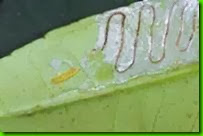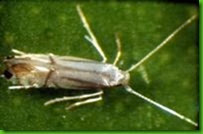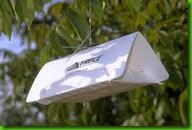Leaf miners are fly, moth or beetle larvae that burrow into leaf tissue, leaving behind the distinctive pale lines and winding trails that are among the most recognizable of pest damage symptoms. Not only do they damage the plant growth, but they in turn reduce crop production and are very unsightly. During summer, the females make little nicks in the leaf surface to lay their eggs. A week later, these hatch into larvae, which tunnel along just under the leaf surface to feed. After 2-3 weeks, the larvae pupate inside the leaves and emerge as adults. The damage is mostly cosmetic but where many leaves are affected, the plant may be weakened or die. Different species of leaf miner fly affect specific plants.

What should I do?
Pinch off infected leaves as soon as the first 'wiggling' trails are seen and dispose of them in the bin or burn them immediately.
 Mining ornamental fruit Leaf miners that attack fruit trees and bushes are mostly larvae of small moths. There can be outbreaks on apples, blackberries, pears, plums and cherries. Apples can be attacked by the apple pygmy moth Stigmella malella and the apple leaf miner Lyonetia clerkella. Moths can have three generations a year and produce extensive leaf mines as larvae.
Mining ornamental fruit Leaf miners that attack fruit trees and bushes are mostly larvae of small moths. There can be outbreaks on apples, blackberries, pears, plums and cherries. Apples can be attacked by the apple pygmy moth Stigmella malella and the apple leaf miner Lyonetia clerkella. Moths can have three generations a year and produce extensive leaf mines as larvae.Blackberries can have two different types of leaf miners on them - Nepticula aurella, which leaves a very winding mine near to the leaf edge, or Tischeria marginea, which tends to produce a large mined area from the main vein to the leaf edge.
Pear trees often have Phyllonorycta corylifoliella, here the pest produces a mined area in the middle section of the leaf. It can also affect Crataegus, Corylus, Sorbus and Malus species. Delta traps may be used to monitor codling moth.
If you have any indoor fruits like Citrus, leafminer larvae can also feed here on the young leaves of citrus trees. The pest is most commonly found on oranges, lemons and limes too. (Adult citrus leafminer)
A common use of control
Pheromone (insect sex attractant) are a useful tool for detecting leafminers, determining when moths are flying and depositing eggs. However, they do not catch enough of the population to be used for control. Only male moths are drawn to the pheromone and become caught in the trap's sticky coating. Identify trapped moths before you decide to take a control action. Check traps every week for moths. The most important times to check are when the moth is most abundant and citrus is flushing in summer and fall.
Biological Control
Leafminers are killed by various parasites and predators, including tiny nonstinging, naturally occurring wasps such as Cirrospilus and Pnigalio species. The parasites lay their eggs inside the mine, inside or on top of the leafminer larva. When the parasite egg hatches the parasite larva consumes the leafminer larva. These parasites are very important for reducing citrus leafminer levels but may not be as affective on plants outside as the environment is not as easily controlled.
Cultural Control
Avoid pruning live branches of fruit trees more than once a year, so that the cycles of flushing are uniform and short. Once the leaves harden, the pest will not be able to mine the leaves. Do not apply nitrogen fertilizer at times of the year when leafminer populations are high and flush growth will be severely damaged, such as in the summer and fall.
Physical Control
Vigorous shoots known as water sprouts often develop on branches and above the graft union on the trunk of mature fruit trees. These shoots grow rapidly and produce new leaves for a prolonged period of time. Remove water sprouts that might act as a site for the moths to lay eggs (oviposition). Suckers, the vigorous shoots which grow from the trunk below the graft union, should always be removed since they originate from the root stock and do not usually produce desirable fruit.
Chemical Control

Insecticide products that contain the natural insecticides azadirachtin or spinosad show some efficacy against larvae and are safe for natural enemies. However, the residues do not last very long, and these insecticides might need to be reapplied every 7 to 14 days. Application of Green Light Spinosad is limited to 6 times per season. Imidacloprid (Bayer Advanced Fruit, Citrus, and Vegetable Insect Control) applied to the ground at the base of fruit trees provides the longest period of control, 1 to 3 months. Imidacloprid should only be applied once a year. Imidacloprid applications should be timed to protect periods of leaf flushing, such as in the spring and fall. Imidacloprid takes 1 to 2 weeks to move from the roots to the leaves, so it should be applied as soon as new flush begins to appear. To protect bees, avoid applying imidacloprid during the period 1 month prior to or during bloom. Removing blossoms before they open on young trees will prevent honey bee exposure to imidacloprid in the nectar/pollen.
Frequent use of broad-spectrum insecticides such as malathion, carbaryl, and pyrethroids are not recommended as they will kill beneficial insects and can result in a buildup of whiteflies, scale insects, and other pests.
If there is major damage to vegetables, or even your herbs, it may be best to start again if failure to remove the leaves where the miner has burrowed still has not eradicated the problem.

No comments:
Post a Comment